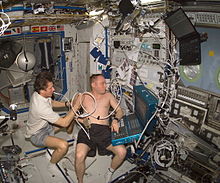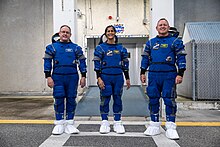| Mike Fincke | |
|---|---|
 Fincke in April 2006 Fincke in April 2006 | |
| Born | Edward Michael Fincke (1967-03-14) March 14, 1967 (age 57) Pittsburgh, Pennsylvania, U.S. |
| Other names | Sparky, Spanky |
| Education | Massachusetts Institute of Technology (BS) Stanford University (MS) El Camino College (AS) University of Houston (MS) |
| Space career | |
| NASA astronaut | |
| Rank | Colonel, USAF (ret.) |
| Time in space | 381d 15h 11m |
| Selection | NASA Group 16 (1996) |
| Total EVAs | 9 |
| Total EVA time | 48h 37m |
| Missions | Soyuz TMA-4 (Expedition 9) Soyuz TMA-13 (Expedition 18) STS-134 |
| Mission insignia |   |
Edward Michael "Mike" Fincke (born March 14, 1967) is an American astronaut who formerly held the American record for the most time in space (381.6 days). His record was broken by Scott Kelly on October 16, 2015.
Mike Fincke was born in Pittsburgh, Pennsylvania, but considers its suburb Emsworth to be his hometown. He is a retired United States Air Force officer and an active NASA astronaut. So far he served two tours aboard the International Space Station as a flight engineer and commander. He flew on one Space Shuttle mission, STS-134 as a mission specialist. Fincke is conversant in Japanese and Russian. He is married to Renita Saikia, and together, they have three children; son Chandra and daughters Tarali and Surya.
Fincke logged just under 382 days in space, placing him sixth among American astronauts for the most time in space and 40th overall. He completed nine spacewalks in Russian Orlan spacesuits and American EMUs. His total EVA time is 48 hours and 37 minutes, placing him 14th all time on the list of spacewalkers.
Education
Fincke graduated from Sewickley Academy in Sewickley, Pennsylvania, in 1985. He attended the Massachusetts Institute of Technology on an Air Force ROTC scholarship and graduated in 1989 with a Bachelor of Science degree in aeronautics and astronautics as well as a Bachelor of Science degree in Earth, atmospheric and planetary sciences. He then received a Master of Science degree in aeronautics and astronautics from Stanford University in 1990, and a second Master of Science degree in planetary geology from the University of Houston–Clear Lake in 2001. He also attended El Camino College in Torrance, California, where he studied Japanese and geology.
Career
Immediately after graduating from MIT in 1989, Fincke attended a summer exchange program with the Moscow Aviation Institute in the former Soviet Union, now Russia, where he studied Cosmonautics. After graduation from Stanford University in 1990, Fincke entered the United States Air Force where he was assigned to the Air Force Space and Missiles Systems Center, Los Angeles Air Force Base in California. There he served as a Space Systems Engineer and a Space Test Engineer. In 1994, upon completion of the U.S. Air Force Test Pilot School, Edwards Air Force Base in California, Fincke joined the 39th Flight Test Squadron, Eglin Air Force Base in Florida, where he served as a flight test engineer working on a variety of flight test programs, flying the F-16 and F-15 aircraft. In January 1996, he reported to the Gifu Test Center, Gifu Air Base in Japan, where he was the United States flight test liaison to the Japanese/United States XF-2 fighter program. By 2005, Fincke had accumulated over 800 flight hours in more than 30 different varieties of aircraft and held the rank of colonel. Fincke belongs to the Geological Society of America and the British Interplanetary Society.
NASA career
Fincke was selected by NASA in April 1996 to be an astronaut. He reported to the Johnson Space Center in August 1996. Having completed two years of training and evaluation, he was assigned technical duties in the Astronaut Office Station Operations Branch serving as an International Space Station spacecraft communicator (ISS CAPCOM), a member of the Crew Test Support Team in Russia and as the ISS crew procedures team lead.
In July 1999, Fincke was assigned as backup crewmember for the International Space Station Expedition 4 crew. Additionally he served as a backup for the ISS Expedition 6 crew and is qualified to fly as a left-seat flight engineer (co-pilot) on the Russian Soyuz spacecraft. He was the commander of the second NASA Extreme Environment Mission Operations (NEEMO 2) mission, living and working underwater for 7 days in May 2002.
In 2013, Fincke served as cavenaut into the ESA CAVES training in Sardinia, alongside Soichi Noguchi, Andreas Mogensen, Nikolai Tikhonov, Andrew Feustel and David Saint-Jacques.
Expedition 9

Fincke was the space station science officer and flight engineer for ISS Expedition 9 from April 18 through October 23, 2004. Expedition 9 was launched from the Baikonur Cosmodrome, Kazakhstan aboard the Soyuz TMA-4 spacecraft, and docked with the International Space Station on April 21, 2004. Fincke spent six months aboard the ISS continuing ISS science operations, maintaining station systems, and performing four spacewalks. The Expedition-9 mission concluded with undocking from the station and safe landing back in Kazakhstan on October 23, 2004. Fincke completed his first mission in 187 days, 21 hours and 17 minutes, and logged a total of 15 hours, 45 minutes and 22 seconds of EVA time in four spacewalks.
Fincke was the backup commander for Expedition 13 and Expedition 16.
Expedition 18

Fincke was commander of Expedition 18. He arrived at the International Space Station aboard the Soyuz TMA-13 on October 14, 2008, with Cosmonaut Yuri Lonchakov and space flight participant Richard Garriott. While Richard Garriott was aboard, Fincke participated during his personal time (along with Yury Lonchakov, Gregory Chamitoff and Richard Garriott) in filming and starring in a science-fiction movie made in space, Apogee of Fear. On April 8, 2009, Fincke, Lonchakov and space tourist Charles Simonyi returned to Earth aboard the TMA-13.
Replacing Fincke as commander of the space station was Gennady Padalka, whom Fincke served with on Expedition 9.
STS-134
Fincke was a mission specialist on STS-134, which was his first and only flight on a Space Shuttle. Fincke made three spacewalks during the mission. He has completed 26 hours and 12 minutes of spacewalking time, bringing his total EVA time to 48 hours and 37 minutes. This places him 11th all time on the list of spacewalkers.
Commercial Crew Program

On January 22, 2019, NASA announced that Fincke would fly on Boeing CST-100 Starliner’s Crew Flight Test, scheduled at the time for 2022. The Starliner’s Crew Flight Test would be the first time that the new spacecraft, which was developed and built by Boeing as part of NASA’s Commercial Crew Program, would be launched into space with humans on board. Fincke took the place of astronaut Eric Boe, who was originally assigned to the mission in August 2018 but became unable to fly due to medical reasons. Boe replaced Fincke as the assistant to the chief for commercial crew in the astronaut office at NASA’s Johnson Space Center. On June 16, 2022, NASA confirmed that CFT would be a two-person flight test, consisting of Wilmore and Williams. Fincke trained as the backup spacecraft test pilot and remained eligible for assignment to a future mission. On September 30, 2022, NASA announced that Fincke would fly as the pilot on the Starliner's first operational mission, Boeing Starliner-1 (PCM-1).
Acting
- Fincke was a guest star on the final episode of Star Trek: Enterprise along with fellow astronaut Terry Virts.
- He was also featured in the Star Trek: First Contact Blu-ray special features, talking about what it is like to work in space and how Star Trek influences people to believe in the magic of space travel.
- Fincke appeared in The Wiggles video Wiggle Around the Clock (2006), demonstrating a space suit.
- Fincke voiced himself in the Season 14 Arthur episode "Buster Spaces Out".
- Fincke also appeared in Man on a Mission: Richard Garriott's Road to the Stars, a documentary based on Richard Garriott's Spaceflight as a fellow astronaut who launched to the ISS with Garriott on a Soyuz Spacecraft
Awards and decorations

|
Master Astronaut Observer Badge |

|
Command Space Operations Badge |
| Meritorious Service Medal | |
| Air Force Commendation Medal with two oak leaf clusters | |
| Air Force Achievement Medal with oak leaf cluster | |
| NASA Distinguished Service Medal with oak leaf cluster | |
| NASA Space Flight Medal with two oak leaf clusters | |
| National Defense Service Medal with service star | |
| Air Force Training Ribbon |
- Distinguished graduate from the United States Air Force ROTC, Squadron Officer School and Test Pilot School Programs
- Recipient of the United States Air Force Test Pilot School Colonel Ray Jones Award as the top Flight Test Engineer/Flight Test Navigator in class 93B
- Recipient of the Sewickley Academy Distinguished Alumnus/a Award in 2005
References
![]() This article incorporates public domain material from websites or documents of the National Aeronautics and Space Administration.
This article incorporates public domain material from websites or documents of the National Aeronautics and Space Administration.
- Cowling, Keith (January 25, 2009). "Today's Videos: ISS Tour With Spanky". NASA Watch. Toronto: Spaceref.com. Archived from the original on July 12, 2012.
- ^ "Michael Fincke Biography". NASA. 2020. Retrieved July 6, 2021.
- Sauro, Francesco; De Waele, Jo; Payler, Samuel J.; Vattano, Marco; Sauro, Francesco Maria; Turchi, Leonardo; Bessone, Loredana (July 1, 2021). "Speleology as an analogue to space exploration: The ESA CAVES training programme". Acta Astronautica. 184: 150–166. Bibcode:2021AcAau.184..150S. doi:10.1016/j.actaastro.2021.04.003. hdl:11585/819077. ISSN 0094-5765. S2CID 234819922.
- Malik, Tariq (January 17, 2009). "Space Commander Cheers for Steelers in NFL Playoff". Space.com.
- Bob Granath (January 22, 2019). "NASA Announces Updated Crew Assignment for Boeing Flight Test Retrieved on January 22, 2019". NASA. Retrieved January 22, 2019.
- Potter, Sean (June 16, 2022). "NASA Updates Astronaut Assignments for Boeing Starliner Test Flight". NASA. Retrieved June 17, 2022.
- "NASA Updates Crew Assignments for First Starliner Crew Rotation Flight – NASA". Retrieved January 15, 2024.
 This article incorporates text from this source, which is in the public domain.
This article incorporates text from this source, which is in the public domain.
- JSC, Amiko Nevills (July 20, 2016). "Final Frontier Astronauts Land on Star Trek". NASA. Retrieved August 3, 2020.
- Wright, matt (September 26, 2009). "Review – Star Trek The Next Generation Movies Blu-ray Box Set". TrekMovie.com. Retrieved January 15, 2023.
- The Wiggles. Wiggle Around the Clock (DVD). HIT Entertainment.
- Booth, John (October 10, 2011). "The 15 Geekiest Episodes of PBS's Arthur". Wired. Archived from the original on August 19, 2013. Retrieved August 14, 2013.
- Fincke Biography
External links
- Michael Fincke on Twitter

- NASA biography
- Spacefacts biography of Mike Fincke
- International Space Station Tour (part 1 of 4)
- Interview with The Scholars' Avenuve, IIT Kharagpur
| Preceded bySergei Volkov | ISS Expedition Commander October 24, 2008, to April 8, 2009 |
Succeeded byGennady Padalka |
| NASA Astronaut Group 16, "The Sardines", 1996 | |||||||
|---|---|---|---|---|---|---|---|
| NASA Astronaut Group 15 ← NASA Astronaut Group 16 → NASA Astronaut Group 17 | |||||||
| Pilots | |||||||
| Mission specialists |
| ||||||
| International mission specialists |
| ||||||
| |||||||
- 1967 births
- Living people
- Aquanauts
- Commanders of the International Space Station
- Military personnel from Pittsburgh
- Space systems engineers
- United States Air Force officers
- University of Houston–Clear Lake alumni
- MIT School of Engineering alumni
- U.S. Air Force Test Pilot School alumni
- United States Air Force astronauts
- Sewickley Academy alumni
- Space Shuttle program astronauts
- Spacewalkers